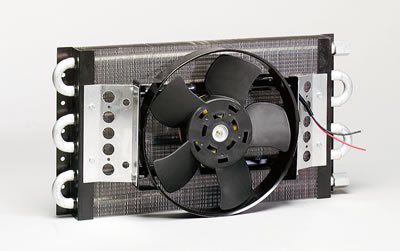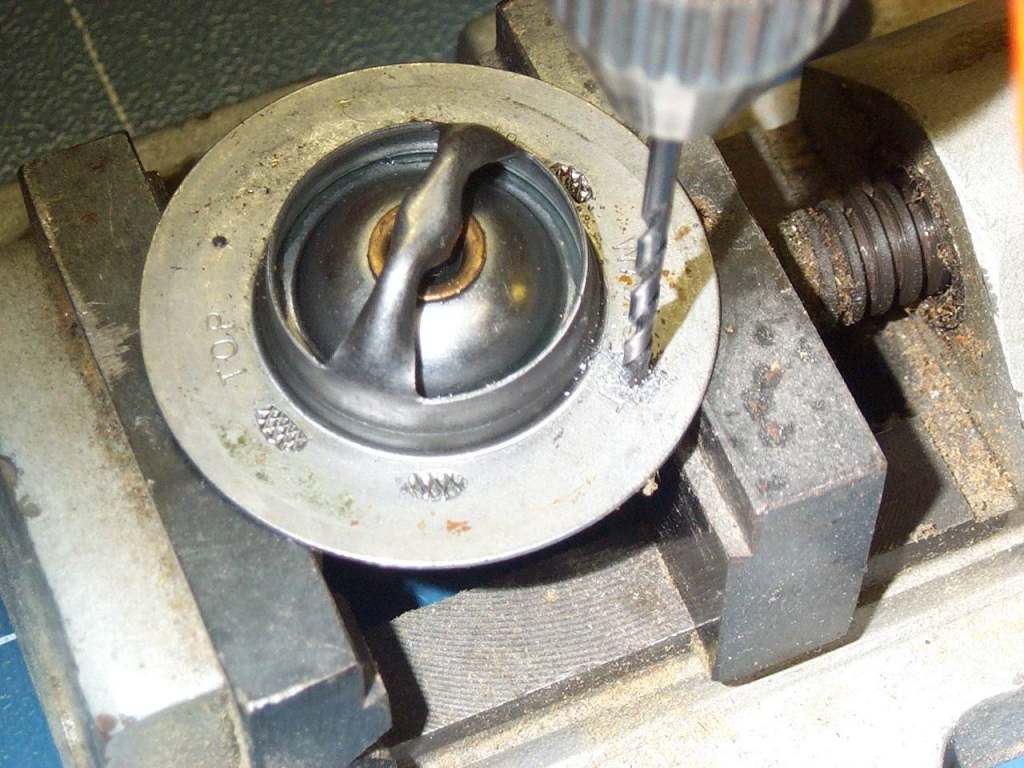FROM TVR-383
Hi GRUMPYVETTE!
running a SBC in a track car here in Scotland. Not too many Chevy motors here (don't actually know of another one!) so not too much local knowledge to rely on. Gradually got through most of the problems but this one now has me stumped.
The motor is a new-build based on an old (1978ish) iron block; all new internals, stroked with Dart heads, roller cam etc. We've had it dyno'd at pretty much 500BHP on the money at 6500RPM so it's making decent power - and generating loads of heat.
Everything is fine running at say 90% throttle/revs; water stays around 85C/185F and the oil is around 95C/203F. But give it full power through to 6500RPM (on track) and the oil quickly rises to the point where I ease off at 120C/248F. I haven't ran it past 120C/248F to see if it stabilizes as I think that's getting too hot...but happy if someone wants to tell me 120C and above is fine.
This will happen in maybe 5 hot laps (so 7 miles or so on my local circuit). Ease off a bit and the temp will come back down to 95C/203F in a couple of laps.
I've tried all sorts pf things to cool the oil but I'm running out of ideas now (assumimg 120C is too hot). First I added a 12" wide 19 row oil cooler; then a second. Then I took off the thermostatic take-off plate so now the oil has no choice but to run through both coolers one after the other. Then I added 'always-on' fans to both coolers! I don't really have space for a third oil cooler, and in reality the second cooler didn't make too much difference anyway.
I am measuring the oil temp in the sump (wet sump - Canton) so the oil lubing the engine is going to be cooler since it must run through the coolers after the pump, and I've good oil pressure - 45PSI at tickover even when hot.
So, assuming 120C/248F is hot enough for oil in the sump (Valvoline Racing mineral), any other ideas of how to keep the temperature down? Or can I run with oil hotter than that in the sump?
...and this isn't even a hot country! We're lucky to see 80 degrees in summer! Vacationed in Vegas lastly week and hired a Hertz Corvette. Stunning car, and even thrashing it through Death Valley at 125 degrees everything stayed under control.
In fairness my water temps are always fine now, which is why I'm even more confused when the oil temp rises so quickly and the water temp stays pretty steady. No thermostat on oil or water, and radiator and oil coolers are side-by-side at the front of the car and get the same airflow.
I was always under the impression that Chevys liked thicker mineral oils, and I should avoid synthetics? Not true then?
Rapidly running out of ideas....
first suggestion swap to a decent synthetic oil in the 10w30 range or at least the thinnest viscosity that maintains 20 psi at hot idle temps, as SYNTHETICS don,t generally start breaking down until about 280F PLUS while mineral base oils tend to start degrading after repeated 250F use, and the thinner the oil the faster it circulates thru the clearances, and the faster heats absorbed and transferred out off the hotter components
and Id need to know more about the complete engine parts list, clearances, etc. but Id sure want to verify the fuel/air ratio is at about 12.6:1 not a lot leaner and your ignition timing was carefully checked to not be a couple degrees advanced from ideal., and that your running a 7-8 quart oil pan, heres the oil cooler I use and I had to install a thermal switch or it OVER COOLED my engine oil in FLORIDA where average outside air temps closer to 90F
viewtopic.php?f=57&t=1540
viewtopic.php?f=57&t=853
my oil pan looks similar to this
http://canton.carshopinc.com/product_in ... 88bb985ecf
Canton Oil Pans
11-120 and 11-120T Oil Pans

but I extended the sump forward with 14 ga steel and a tig welder to add 4 inches extra to the sump to get 10 qt capacity
http://www.summitracing.com/parts/PRM-1 ... mage=large

CHEVYS LIKING THICKER OIL IS NOT USUALLY TRUE, IF YOUR RUNNING TIGHT CLEARANCES, ITS THE CLEARANCES THAT WILL DETERMINE THE OIL VISCOSITY REQUIRED, TRY THE THINNER SYNTHETIC OIL, as LONG AS YOU HAVE A MINIMUM of 20 PSI at hot idle your fine!
IVE run a MIX of 90%/ synthetic 10% mineral oil in my race cars for many years, its the rate the oil passes over the bearings surface (VOLUME) not the pressure that effects the heat transfer and absorption rates the most. within reasonable limits, the more oil volume flowing over the surface of the bearings the faster the heat transfers, thicker oil takes longer to flow thru the clearances, so it can,t absorb and transfer quite as much heat, as a thinner oil that's moving thru faster.
usually 1 qt MARVEL MYSTERY OIL, 9 qts MOBILE 1 10w30 synthetic
http://www.marvelmysteryoil.com/
https://www.mobiloil.com/USA-English/Mo ... /Oils.aspx
keeping the oil cool basically comes down to having the oil flow thru both the engine and the cooler but having the surface area of the cooler large enough and the number of passes thru the cooler ,allow the oil to transfer most of the heats its absorbed in the engine back out into the air flowing thru the cooler,before its routed back to the engine,and that generally requires ducting cool air into the cooler and placing it where the flows not restricted, on my corvette I removed the rear spare tire, and built a mount that allowed a good deal of clearance and no significant engine heat, with it working all the time I had problems getting the heat over 220 f and it mostly stayed at or near 200f,theres basically about 3 qts in the upper engine and oil passages at any time , absorbing heat so having a similar volume in the cooler, releasing heat during the same time makes sense, and having a similar amount in the baffled oil pan sump and filter sure helps,naturally if you have the oil routed to spend more time with the majority of the oil being heated and less of the oils times spent cooling average temperatures rise rapidly
viewtopic.php?f=54&t=52
viewtopic.php?f=54&t=150
viewtopic.php?f=54&t=615
viewtopic.php?f=54&t=65
viewtopic.php?f=54&t=117

drilling 4-6 3/32" holes spaced evenly in the t-stat flange tends to make the coolant temps more consistent, and has no effect once the engine up to temperature, I have no idea why the factory does not do so, while its true that the holes tend to slow the engines required time to reach operational temperatures its also true that it prevents air from being trapped under the thermostat and and reduces temperature swings a good deal as the t-stat opens and closes
Hi GRUMPYVETTE!
running a SBC in a track car here in Scotland. Not too many Chevy motors here (don't actually know of another one!) so not too much local knowledge to rely on. Gradually got through most of the problems but this one now has me stumped.
The motor is a new-build based on an old (1978ish) iron block; all new internals, stroked with Dart heads, roller cam etc. We've had it dyno'd at pretty much 500BHP on the money at 6500RPM so it's making decent power - and generating loads of heat.
Everything is fine running at say 90% throttle/revs; water stays around 85C/185F and the oil is around 95C/203F. But give it full power through to 6500RPM (on track) and the oil quickly rises to the point where I ease off at 120C/248F. I haven't ran it past 120C/248F to see if it stabilizes as I think that's getting too hot...but happy if someone wants to tell me 120C and above is fine.
This will happen in maybe 5 hot laps (so 7 miles or so on my local circuit). Ease off a bit and the temp will come back down to 95C/203F in a couple of laps.
I've tried all sorts pf things to cool the oil but I'm running out of ideas now (assumimg 120C is too hot). First I added a 12" wide 19 row oil cooler; then a second. Then I took off the thermostatic take-off plate so now the oil has no choice but to run through both coolers one after the other. Then I added 'always-on' fans to both coolers! I don't really have space for a third oil cooler, and in reality the second cooler didn't make too much difference anyway.
I am measuring the oil temp in the sump (wet sump - Canton) so the oil lubing the engine is going to be cooler since it must run through the coolers after the pump, and I've good oil pressure - 45PSI at tickover even when hot.
So, assuming 120C/248F is hot enough for oil in the sump (Valvoline Racing mineral), any other ideas of how to keep the temperature down? Or can I run with oil hotter than that in the sump?
...and this isn't even a hot country! We're lucky to see 80 degrees in summer! Vacationed in Vegas lastly week and hired a Hertz Corvette. Stunning car, and even thrashing it through Death Valley at 125 degrees everything stayed under control.
In fairness my water temps are always fine now, which is why I'm even more confused when the oil temp rises so quickly and the water temp stays pretty steady. No thermostat on oil or water, and radiator and oil coolers are side-by-side at the front of the car and get the same airflow.
I was always under the impression that Chevys liked thicker mineral oils, and I should avoid synthetics? Not true then?
Rapidly running out of ideas....
first suggestion swap to a decent synthetic oil in the 10w30 range or at least the thinnest viscosity that maintains 20 psi at hot idle temps, as SYNTHETICS don,t generally start breaking down until about 280F PLUS while mineral base oils tend to start degrading after repeated 250F use, and the thinner the oil the faster it circulates thru the clearances, and the faster heats absorbed and transferred out off the hotter components
and Id need to know more about the complete engine parts list, clearances, etc. but Id sure want to verify the fuel/air ratio is at about 12.6:1 not a lot leaner and your ignition timing was carefully checked to not be a couple degrees advanced from ideal., and that your running a 7-8 quart oil pan, heres the oil cooler I use and I had to install a thermal switch or it OVER COOLED my engine oil in FLORIDA where average outside air temps closer to 90F
viewtopic.php?f=57&t=1540
viewtopic.php?f=57&t=853
my oil pan looks similar to this
http://canton.carshopinc.com/product_in ... 88bb985ecf
Canton Oil Pans
11-120 and 11-120T Oil Pans

but I extended the sump forward with 14 ga steel and a tig welder to add 4 inches extra to the sump to get 10 qt capacity
http://www.summitracing.com/parts/PRM-1 ... mage=large

CHEVYS LIKING THICKER OIL IS NOT USUALLY TRUE, IF YOUR RUNNING TIGHT CLEARANCES, ITS THE CLEARANCES THAT WILL DETERMINE THE OIL VISCOSITY REQUIRED, TRY THE THINNER SYNTHETIC OIL, as LONG AS YOU HAVE A MINIMUM of 20 PSI at hot idle your fine!
IVE run a MIX of 90%/ synthetic 10% mineral oil in my race cars for many years, its the rate the oil passes over the bearings surface (VOLUME) not the pressure that effects the heat transfer and absorption rates the most. within reasonable limits, the more oil volume flowing over the surface of the bearings the faster the heat transfers, thicker oil takes longer to flow thru the clearances, so it can,t absorb and transfer quite as much heat, as a thinner oil that's moving thru faster.
usually 1 qt MARVEL MYSTERY OIL, 9 qts MOBILE 1 10w30 synthetic
http://www.marvelmysteryoil.com/
https://www.mobiloil.com/USA-English/Mo ... /Oils.aspx
keeping the oil cool basically comes down to having the oil flow thru both the engine and the cooler but having the surface area of the cooler large enough and the number of passes thru the cooler ,allow the oil to transfer most of the heats its absorbed in the engine back out into the air flowing thru the cooler,before its routed back to the engine,and that generally requires ducting cool air into the cooler and placing it where the flows not restricted, on my corvette I removed the rear spare tire, and built a mount that allowed a good deal of clearance and no significant engine heat, with it working all the time I had problems getting the heat over 220 f and it mostly stayed at or near 200f,theres basically about 3 qts in the upper engine and oil passages at any time , absorbing heat so having a similar volume in the cooler, releasing heat during the same time makes sense, and having a similar amount in the baffled oil pan sump and filter sure helps,naturally if you have the oil routed to spend more time with the majority of the oil being heated and less of the oils times spent cooling average temperatures rise rapidly
viewtopic.php?f=54&t=52
viewtopic.php?f=54&t=150
viewtopic.php?f=54&t=615
viewtopic.php?f=54&t=65
viewtopic.php?f=54&t=117

drilling 4-6 3/32" holes spaced evenly in the t-stat flange tends to make the coolant temps more consistent, and has no effect once the engine up to temperature, I have no idea why the factory does not do so, while its true that the holes tend to slow the engines required time to reach operational temperatures its also true that it prevents air from being trapped under the thermostat and and reduces temperature swings a good deal as the t-stat opens and closes
